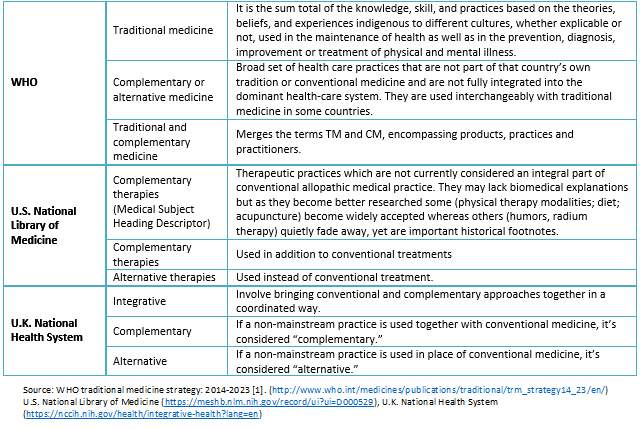Letters to the editor
← vista completaPublished on June 8, 2017 | http://doi.org/10.5867/medwave.2017.05.6976
Alternative, traditional, or complementary medicine: A perspective of intercultural therapeutic adherence
Medicina tradicional, alternativa o complementaria: una perspectiva de adherencia terapéutica intercultural
Dear Editor:
World Health Organization proposed the 2014-2023 traditional medicine strategy based on objectives that include the implementation in member countries health systems [1], with similar definitions used for alternative medicine and complementary medicine; however there were both different from traditional medicine (Table 1). Other organizations distinguished between alternative medicine and complementary medicine (Table 1), depending on their role of replacement or accompanying conventional therapy.
 Full size
Full size Adequate definition of these concepts is globally relevant, specifically for those countries with an old traditional medicine deep-rooted in population culture. In limited resources countries, regions and/or strata, traditional medicine is used alternatively ("in substitution") to conventional medicine, due to historical (oral tradition), cultural (community customs), social (limited access to conventional medicine) and economic influences. On the other hand, it is used in high resources countries, regions and/or strata, like a complementary tool ("in company") to conventional medicine.
Traditional medicine presents therapeutic features for certain cultural contexts that could be more relevant than those provided by conventional medicine could. Considering the validity of a therapeutic system is based on the ability to solve population health problems, in certain circumstances, this premise is fulfilled by the traditional medicine; being widely used as an alternative medicine, in several countries with an ancestral culture such as Mexico, Chile or Peru [2]. In these countries the alternative medicine is used as an initial disease management strategy, in parallel to the symptoms presentation (pre-diagnosis period), generating a diagnostic delay in curable illnesses with timely diagnosis [3] and leading to an increase in global morbidity and mortality. On the other hand, complementary medicine is more commonly used in addition to conventional treatment (therapeutic period), especially in some chronic pathologies, and in recent years associated more frequently with oncological diseases [3],[4].
Given these circumstances, the question arises: What should be the health strategy to achieve an adequate implementation of traditional medicine, without generating greater morbidity and mortality? A unique and relevant experience in the highlands of Ancash (north of Peru) is based on the therapeutic indication of some gastroenterologists, who accompany the antibiotic treatment for infectious gastrointestinal diseases, with medicinal plants frequently used by the population as an alternative therapy. In this specific case, the recommendation of using medicinal plants such as the “muña” (Minthostachys mollis) [5] and others that have shown an antibacterial effect [6],[7], can achieve a greater therapeutic adherence, even when the cultural patients conception may be able to orient to a greater confidence/efficacy in medicinal plants than in the antibiotic treatment.
Finally, this experience raises the need to adequately definition of traditional/alternative/complementary medicine, to establish a health strategy changing the approach of alternative medicine to complementary medicine. This will be considered as the oriented path to an intercultural therapeutic adherence perspective, which has to be understood as two knowledge’s (patient’s conventional and traditional medicine) that converge to solve the population's health problems.
Notes
From the editor
The authors originally submitted this article in Spanish and English. The Journal has not copyedited this English version.
Conflicts of interest
The authors declare no conflict of interest.
Financing
The authors declare that they have not received any funding to carry out this work.

